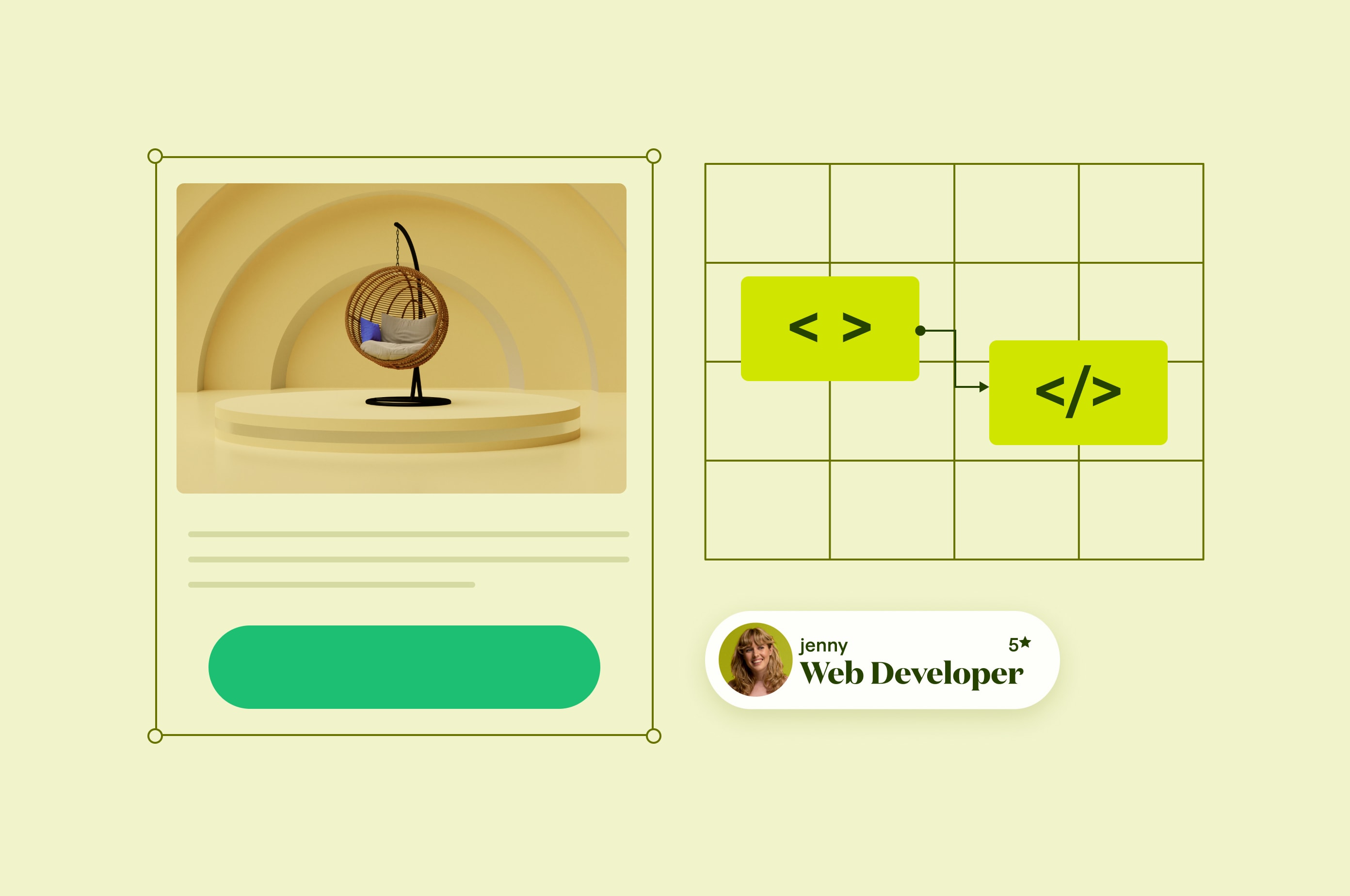How to design a website in 2024 - (a beginner's guide)
All the secrets of website design
 June 26, 2022
June 26, 2022 8 minute reading
8 minute reading
Many business owners understand the importance of an online presence, yet they don’t know where to start. With so many online platforms used for promoting businesses, it can often get overwhelming.
If you wish to sell products or services on the Internet or provide important details about your brand, a website is crucial. Most consumers will expect to find your business online, and failing to have a dedicated site for your brand can make you miss out on vital sales.
From selecting your website builder and domain name to knowing how to design each section of your site, this beginner’s guide will take you through the steps needed to design your own website in 2023.
Here are the key steps for designing your own website from scratch
Why Your Brand Needs a Website
Websites help your brand reach a wider audience and increase your visibility. They also improve your credibility, allow for easier online promotion, and boost your traffic.
Let’s examine the reasons why you need a website in more detail below.
Reach a Wider Audience
Great web page design is an essential tool for attracting new customers and growing your business's income.
If you want to increase organic traffic to your website, you must design your website to appeal to a wide variety of consumers. Most importantly, it should be useful to your target audience and help them in overcoming their problems.
This is because most buyers will visit numerous websites to learn more about different products or services before making their final purchasing decision.
Make Your Brand More Visible
Brand visibility is the degree to which people can recognize or recall a certain brand while other conditions are identical. Think of a supermarket aisle, for example, featuring rows of pasta. Despite the product being extremely similar in nature, a consumer will instantly recognize their favorite brand and choose it over its competitors - often regardless of its price or position on the shelves. In this scenario, we can say the chosen brand has high brand visibility.
Having a website is an effective way to boost your brand’s visibility over its competitors. Marketers can use keywords within the site, for example, to achieve a better understanding of customer opinions and attitudes. This also enables marketers to better target these customers for campaigns that deliver greater results.
Boost Your Credibility
Regardless of how appealing your prices or offers are, visitors are significantly less likely to buy from you if they don't trust you.
While social media platforms can be used to deliver outstanding customer service and build trust, having a website is still crucial in this digitized world.
Your web page design can have a positive impact on a visitor both subliminally and psychologically, and ensure them of these three important factors:
Their transaction will be secure
Your product descriptions are truthful
They can have confidence in your ability to meet your delivery and guarantee responsibilities
When consumers are sure of these three factors, only then will they commit to making a purchase.
Make Online Promotion Easier
A website makes it easier than ever to acquire new buyers, as it gives you complete control over their purchasing experience.
Compiling all of your business information, products, and/or services into a website also makes your online promotional methods easier, as you can focus on driving traffic to one place. As opposed to concentrating on social media platforms, a separate blog, or a standalone eCommerce store, for example, promoting your website gives you more bang for your buck.
When running an online promotion for your website, you can focus your marketing efforts on three key segments:
Consumers who have bought from your brand before or are aware of it
Consumers looking for a similar product to your own
Consumers who may be interested in your products if they were made aware of them
Improves Your Search Engine Traffic
Search engine traffic to your website is an important driver of overall business growth. This is because it improves your search engine ranks, which leads to increased traffic. This traffic then enables you to track marketing activities, improve search engine credibility, discover more about your target audience, and attract more customers.
The strategies listed below are effective for increasing search engine traffic. Implementing these tactics can have a positive influence on your bottom line and boost online sales.
Focusing on long-tail keywords
Partaking in online meetings and events
Building and promoting landing pages
Inviting guest bloggers to contribute to your website's blog
Using a variety of email marketing techniques to communicate with consumers
Making use of analytics
While free content marketing is an excellent starting point, combining your efforts with efficient paid search management will help you attract even more traffic. It's an excellent way to establish your brand and get your business in front of the right people.
Small Business Website Design in 2023: Where to Begin?
Now that you understand the key reasons why you need a website, the next step is to begin designing it using these steps:
1. Decide Who's Going to Build Your Website
When designing a website from scratch, you can either create it yourself using a website builder or outsource the project to a web design agency or freelancer.
Website Builders
A website builder (also known as a Content Management System, or CMS) is a platform that allows you to design, customize, and launch a website without any coding skills.
Website builders offer an "all-inclusive" website design package. This typically includes pre-built website design examples, a drag-and-drop editor, web hosting, a domain name, and email address, and customer support services.
There are many advantages of using a website builder, including:
They’re simple to use
No need for extra software or third-party hosting
No technical skills needed to get started
The website builder platform takes care of updates and security
Preset themes that you can customize to your own preferences
Default mobile optimization of your site
It’s important to point out that using a website builder might not be for everyone, however.
You should also weigh up the following disadvantages:
Depending on the website builder, it's not always possible to include additional features
Because you are reliant on the provider, they're less flexible
They are not intended for more complex web page designs that involve the use of a database, such as a job board or directory
Before Choosing a Website Builder
To choose the correct website builder, you must first decide what sort of website you want to create. Think about your goal for setting up a website, as well as the specific features you'd want on your site.
Next, consider your growth options:
Will your website be regularly updated?
Do you need a blog section?
Do you intend to expand your product line on your website down the track?
When choosing a website builder, keep the following features in mind:
Plugins or modules
Ease of use
Functionality
Customization
SEO functions
Social media tools
Customer service
Page load speed
Ensure the website builder you select will fulfill your needs as your business grows. You can also utilize free trial accounts or money-back guarantee plans to test-drive a website builder before making your final choice.

The Most Popular Options
There are numerous website builders you can choose from when designing your website.
The most popular include:
WordPress
Wix
Squarespace
GoDaddy Website Builder
Weebly
Progress Sitefinity
Hiring an Agency or a Freelance Website Designer
Businesses wanting to take a thorough and staged approach to creating their website often hire a web design agency. Usually, this process will involve a web strategy phase, a design phase, and a web development phase.
Working with an agency has several benefits, including having an entire team committed to your website. The downside to this, however, is that it can be very costly.
If your business is just getting started and wants a simple web page design, a freelance web designer might be an ideal option.
One reason an organization might pick a freelancer over an agency to develop its website is that it’s less expensive. You can also save costs by having a freelancer tweak an existing template or theme, instead of designing a new one from scratch.
2. Choose your Website Host
Having a reputable web hosting provider is critical since this service ensures your website and content are accessible to consumers 24/7.
A reliable website host will also protect your site and back-up its files. In the case of an attack or other issue, you can recover your important website information using your web host's backed-up files.
Failure to have a high-quality web host can result in your website being frequently unavailable. When your website is down, you risk losing customers, revenue, and trust.
If you use a website builder to create your website, web hosting is typically included in the company's services.
Popular Web Hosting Options
The most popular types of web hosting include:
Shared hosting: Shared hosting involves websites sharing resources with other sites on a single server. This is the most basic form of web hosting, making it more suitable for smaller websites.
VPS hosting: Standing for "Virtual Private Server”, this hosting has the same approach as shared hosting. However, the number of sites that share data is considerably reduced, making it more ideal for growing websites.
WordPress Hosting: This hosting is created specifically for use with the WordPress CMS. WordPress hosting is offered in two forms: shared server WordPress hosting and managed WordPress hosting.
Dedicated hosting: This hosting provides you with your own dedicated server. Because you won't be sharing resources with other websites, it allows your site to run at its best. It is, however, the most expensive hosting option.
Cloud hosting: With cloud hosting, each server is responsible for a different set of tasks. If one of the servers has problems, the network's other servers will step in and handle those duties.
3. Data Privacy and Financial Transactions
The Internet is utilized for a wide range of purposes and transactions. Because of this, websites are receiving and storing more customer data than ever before.
While this might benefit organizations by providing them with more vital data to analyze, it also means that hackers will be able to target and steal more information.
You can provide your customers with a genuine sense of security in a number of ways:
Using tools like worldwide IP, Domain Map, and Cookie Tracker, you can examine all cookies set on your website and understand exactly where you can handle your website's data
Recognize the privacy requests of consumers by using the Universal Search feature to locate their data and permanently remove it
Reduce risk by implementing site-wide Data Privacy and Security rules that immediately recognize possible threats to personal data
Establish compliance efforts through the User Actions Log, which captures every action your team takes on the site
10 Things to do When Designing Your Website
To ensure your new website is of the highest quality, there are a few steps you should take before you start building it.
1. Establish Goals for your Website
What's the purpose of your website? What is the most important information you want visitors to understand, and what specific action do you want them to take?
Your goals will vary based on your industry, products or services, the location of your company, and other factors.
These are the top three most typical website goals for most brands:
Increasing the company's revenue
Establishing credibility and boosting brand awareness
Streamlining and automating processes
2. Research Tips and Ideas
Whether you’re hiring a professional web designer or creating the website yourself, ensure your site has these four fundamentals:
It’s free of clutter and looks clean and organized
It uses visual hierarchy (i.e. size and location) to impact what visitors see first, second, etc.
It contains a color scheme that matches your brand’s identity
It uses typography in a way that supports and enhances your brand
3. Understand Your Target Audience
Establishing a target audience is necessary for knowing where to focus your sales and marketing activities. This will assist you in identifying your ideal customer and what they value. This also provides a solid foundation on which to grow your brand.
These steps will help you figure out who your target audience is:
Begin with your existing customers
Gather information about these customers’ demographics
Make a map of your market positioning
Keep an eye out for patterns with customer feedback
Choose your brand's ideal niche
Analyze your competitors
4. Choose a Domain Name for your Website
Like your company name or logo, your domain name is an important part of your brand.
By following simple criteria, you can select a domain name that will help you generate more traffic.
You'll want a domain name that's memorable, distinctive, and easy to say and type. You should also avoid anything that's too long or detailed. Additionally, utilize keywords strategically, and use ".com" as your domain name extension.
5. Prepare your Branding
You'll also need to determine who you are as a business and the mission and values you want to embrace. Additionally, you should consider how different elements (including both visual and non-visual) interact to appeal to your target audience.
If your company offers small but high-priced products, for example, then offering free delivery could be a great approach to promoting your brand identity.
6. Decide on the Design
There are eight key points in designing a website. Getting these right the first time is crucial, as it will save you from having to redo any steps down the line.
Determine your website's main objective
Choose whether to design it yourself or hire a website designer to do it for you
Make sure your website's parts are coherent
Plan your website's navigation system
Give your website an appealing touch
Produce simple but effective web page templates
Create a site that’s optimized for search engines
Make use of interactive material, where relevant
7. Plan the Structure of Your Website
By creating the framework of your website, you can optimize navigation and lay the basis for your future site design.
A Visual Sitemap is a hierarchical chart that represents the page structure of your website. It's similar to a mindmap, where your homepage forms the central idea. From here, your pages will branch off, followed by their sub-pages.
Creating a sitemap gives you a clearer understanding of:
What pages your website will have
What content you'll need to produce
What extra elements or features you need
Which software or platform will work best
8. Create your Website Content
Your website's content will represent your brand's story. Therefore, if you want to send a clear message to your readers, you must produce unique and innovative content.
To do this, ask yourself the following questions before you begin writing:
Will it be interesting and relevant to your target market?
What is the best way to present it to your intended audience?
Then, follow these tips to ensure your website content gets attention:
Be aware of your target market
Use active voice
Avoid jargon
Use clear and concise sentences
Make text scannable with headings, sub-headings, and lists
Get your audience hooked for more
9. Optimize your website for SEO
When you focus on SEO, you choose primary, secondary, and latent semantic keywords that are related to search intent. Then you generate content that people want to read, while also including metadata that helps Google analyze the information.
The steps below will assist you in achieving SEO success
Create content that is both comprehensive and valuable
Conduct in-depth keyword research
Prioritize on-page SEO
Seek high-quality backlinks
Increase the speed of your website
10. Make your website mobile-friendly
A mobile-optimized website also goes hand-in-hand with successful SEO. When a website is mobile-friendly, it means your website also has a mobile version for optimal viewing on the smaller screen of a device.
You can achieve this in three main ways:
Responsive design: when the layout of your website adapts to match a viewer's screen size
Dynamic serving: when viewers see a separate, purpose-built version of the website depending on the device they're using
A mobile app: when viewers can access your website on an entirely separate app for their mobile device instead of viewing a mobile-optimized version
Start Building Your Website
Having a website for your brand is increasingly important in our internet-reliant society. Thankfully, designing your own website isn’t hard to do, nor does it have to be expensive.
With a wide range of DIY options, as well as the ability to outsource the work to freelance web designers, creating an engaging and on-brand website has never been easier.
After learning about the entire process of small business website design, you’re now ready to move forward and create your own. With your new website launched, you’ll be well on your way to higher traffic and sales.



